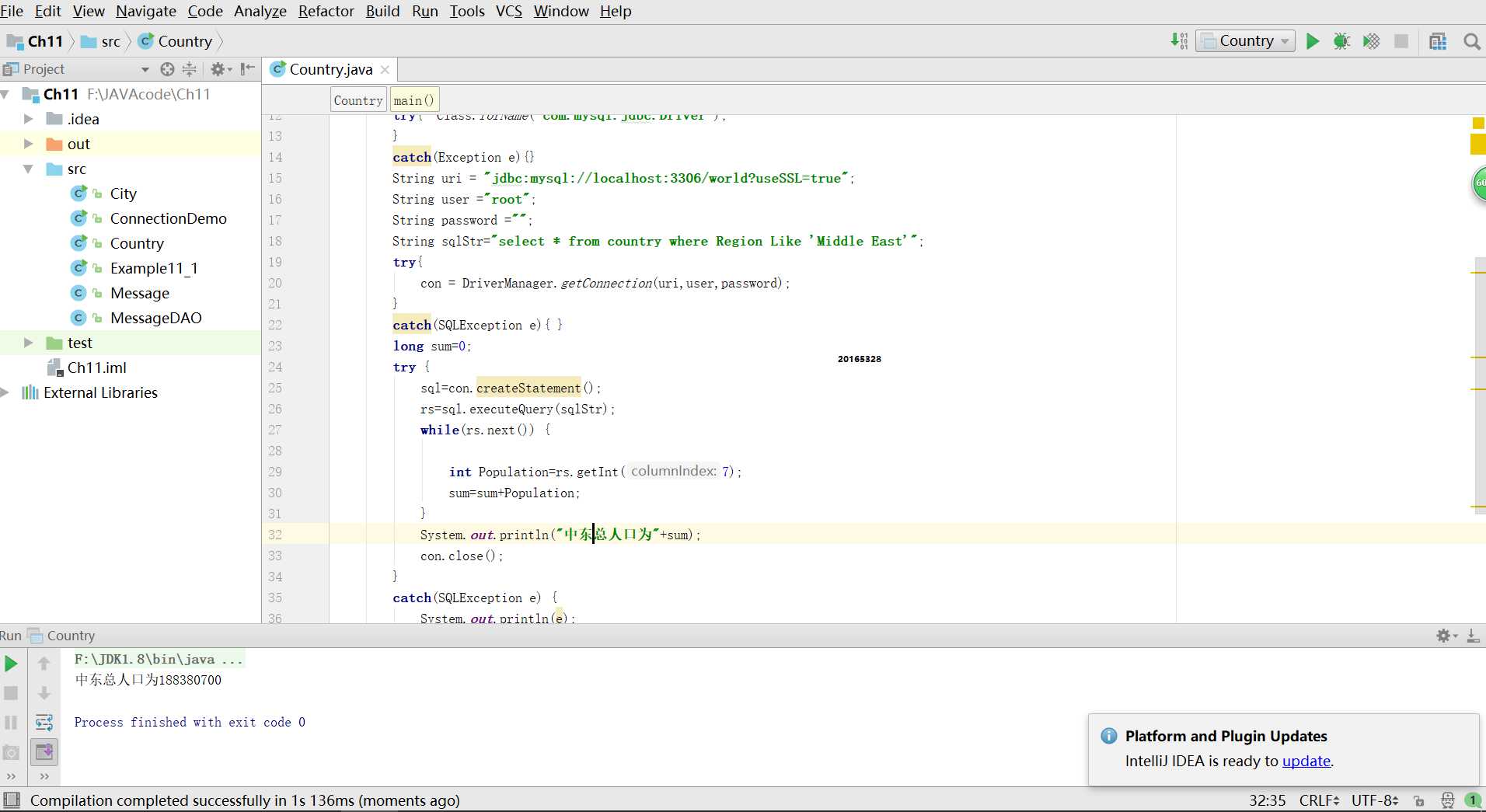20165328课上补做
Posted dky20165328
tags:
篇首语:本文由小常识网(cha138.com)小编为大家整理,主要介绍了20165328课上补做相关的知识,希望对你有一定的参考价值。
一、相关知识点总结:
- 顺序查询:即指ResultSrt对象一次只能看到一个数据行,使用next()方法移到下一个数据行,next()方法最初的查询位置,即游标位置,位于第一行前面。next()方法向下移动游标,移动成功返回ture,否则返回false。
- 条件与排序查询:
- 一般格式:
-
select 字段 form 表名 while 条件
(1)字段值和固定值比较,例如:
-
selet name,height form mess where name=“李四”(2)字段值在某个区间范围,例如:
-
select * form mess where height>1.60 and height<=1.8 select * form mess where mess>1.7 and name !=“张山”
(3)使用某些特殊的日期函数,如year、month、day:
-
select * form mess where year(birthday)<1980 and month(birthday)<=10 select * form mess where year(birthday) between 1983 and 1986
二、课上作业补做截图:


三、第十一章代码分析:
- example11_1
-
import java.sql.*; public class Example11_1 { public static void main(String args[]) { Connection con=null; //初始化 Statement sql; ResultSet rs; //顺序查询,始终保持和数据库的连接,直到将对象中的数据查看完毕 try{ Class.forName("com.mysql.jdbc.Driver"); //加载JDBC_MySQL驱动 } catch(Exception e){} String uri = "jdbc:mysql://localhost:3306/students?useSSL=true"; String user ="root"; String password =""; try{ con = DriverManager.getConnection(uri,user,password); //连接代码 } catch(SQLException e){ } try { sql=con.createStatement(); rs=sql.executeQuery("SELECT * FROM mess"); //查询mess表 while(rs.next()) { //读取数据 String number=rs.getString(1); String name=rs.getString(2); Date date=rs.getDate(3); float height=rs.getFloat(4); System.out.printf("%s\\t",number); System.out.printf("%s\\t",name); System.out.printf("%s\\t",date); System.out.printf("%.2f\\n",height); } con.close(); } catch(SQLException e) { System.out.println(e); } } }
该代码作用为查询student数据库中mess表的全部记录。
- example11_2:
-
import java.sql.*; public class Example11_2 { public static void main(String args[]) { Connection con; Statement sql; ResultSet rs; con = GetDBConnection.connectDB("students","root",""); //连接数据库 if(con == null ) return; //若数据为空 try { sql=con.createStatement(ResultSet.TYPE_SCROLL_SENSITIVE, ResultSet.CONCUR_READ_ONLY); //为得到一个可滚动的结果集 rs = sql.executeQuery("SELECT * FROM mess "); //根据参数ResultSet.TYPE_SCROLL_SENSITIVE和ResultSet.CONCUR_READ_ONLY的情况,sql返回相应类型的结果集 rs.last(); int max = rs.getRow(); System.out.println("表共有"+max+"条记录,随机抽取2条记录:"); int [] a =GetRandomNumber.getRandomNumber(max,2);//得到1-max之间2个不同随机数 for(int i:a){ rs.absolute(i);//油标移动到第i行 String number = rs.getString(1); String name = rs.getString(2); Date date = rs.getDate(3); float h = rs.getFloat(4); System.out.printf("%s\\t",number); System.out.printf("%s\\t",name); System.out.printf("%s\\t",date); System.out.printf("%.2f\\n",h); } con.close(); } catch(SQLException e) { System.out.println(e); } } }
该代码是将数据库连接的代码单独封装到一个GetDatebaseConnection类中,随机查询student数据库中mess表的两条记录
- example11_3:
-
import java.sql.*; public class Example11_3 { public static void main(String args[]) { Connection con; Statement sql; ResultSet rs; con = GetDBConnection.connectDB("students","root","");//连接数据库 if(con == null ) return; //若数据为空 String c1=" year(birthday)<=2000 and month(birthday)>7"; //条件1:若出生的年份在2000年或者2000年之前,月份在7月之后 String c2=" name Like ‘张_%‘"; //条件2:学生姓张 String c3=" height >1.65"; //条件3:身高大于1.65 String sqlStr = "select * from mess where "+c1+" and "+c2+" and "+c3+"order by birthday"; //通过where查找和通过order by排序 try { sql=con.createStatement(); rs = sql.executeQuery(sqlStr); while(rs.next()) { String number=rs.getString(1); String name=rs.getString(2); Date date=rs.getDate(3); float height=rs.getFloat(4); System.out.printf("%s\\t",number); System.out.printf("%s\\t",name); System.out.printf("%s\\t",date); System.out.printf("%.2f\\n",height); } con.close(); } catch(SQLException e) { System.out.println(e); } } }
该代码的作用是查询mess表中姓张,身高大于1.65,出生年份在2000年或2001以前,月份在7月之后的学生,并按出生日期排序。
- example11_4:
-
import java.sql.*; public class Example11_4 { public static void main(String args[]) { Connection con; Statement sql; ResultSet rs; con = GetDBConnection.connectDB("students","root",""); //连接数据库 if(con == null ) return; String jiLu="(‘R11q‘,‘王三‘,‘2000-10-23‘,1.66),"+ "(‘R10q‘,‘李武‘,‘1989-10-23‘,1.76)"; //插入的2条记录 String sqlStr ="insert into mess values"+jiLu; //通过insert into mess values语句进行插入记录 try { sql=con.createStatement(); int ok = sql.executeUpdate(sqlStr); rs = sql.executeQuery("select * from mess"); while(rs.next()) { String number=rs.getString(1); String name=rs.getString(2); Date date=rs.getDate(3); float height=rs.getFloat(4); System.out.printf("%s\\t",number); System.out.printf("%s\\t",name); System.out.printf("%s\\t",date); System.out.printf("%.2f\\n",height); } con.close(); } catch(SQLException e) { System.out.println("记录中number值不能重复"+e); } } }
该代码是向mess插入两条记录。
- example11_5:
-
import java.sql.*; public class Example11_5 { public static void main(String args[]) { Connection con; PreparedStatement preSql; //预处理语句对象preSql ResultSet rs; con = GetDBConnection.connectDB("students","root",""); //连接数据库 if(con == null ) return; String sqlStr ="insert into mess values(?,?,?,?)"; //在对SQL进行预处理时可以使用通配符?来代替字段的值 try { preSql = con.prepareStatement(sqlStr);//得到预处理语句对象preSql preSql.setString(1,"A001"); //设置第1个?代表的值 preSql.setString(2,"刘伟"); //设置第2个?代表的值 preSql.setString(3,"1999-9-10"); //设置第3个?代表的值 preSql.setFloat(4,1.77f); //设置第4个?代表的值 int ok = preSql.executeUpdate(); sqlStr="select * from mess where name like ? "; preSql = con.prepareStatement(sqlStr);//得到预处理语句对象preSql preSql.setString(1,"张%"); //设置第1个?代表的值 rs = preSql.executeQuery(); while(rs.next()) { String number=rs.getString(1); String name=rs.getString(2); Date date=rs.getDate(3); float height=rs.getFloat(4); System.out.printf("%s\\t",number); System.out.printf("%s\\t",name); System.out.printf("%s\\t",date); System.out.printf("%.2f\\n",height); } con.close(); } catch(SQLException e) { System.out.println("记录中number值不能重复"+e); } } }
该代码是使用预处理语句向mess表添加记录并查询了姓张的记录。
- example11_6:
-
import javax.swing.*; public class Example11_6 { public static void main(String args[]) { String [] tableHead; String [][] content; JTable table ;//定义表格 JFrame win= new JFrame(); Query findRecord = new Query(); findRecord.setDatabaseName("students"); findRecord.setSQL("select * from mess"); content = findRecord.getRecord(); //返回二维数组,即查询的全部记录 tableHead=findRecord.getColumnName(); //返回全部字段名 table = new JTable(content,tableHead); //表格JTable win.add(new JScrollPane(table)); win.setBounds(12,100,400,200); win.setVisible(true); win.setDefaultCloseOperation(JFrame.EXIT_ON_CLOSE); } }
该代码将数据库名以及SQL语句传递给Query类的对象。
- example11_7:
-
import java.sql.*; public class Example11_7{ public static void main(String args[]){ Connection con = null; //初始化 Statement sql; ResultSet rs; String sqlStr; con = GetDBConnection.connectDB("students","root",""); //连接数据库 if(con == null ) return; try{ float n = 0.02f; con.setAutoCommit(false); //关闭自动提交模式 sql = con.createStatement(); sqlStr = "select name,height from mess where number=‘R1001‘"; rs = sql.executeQuery(sqlStr); rs.next(); float h1 = rs.getFloat(2); System.out.println("事务之前"+rs.getString(1)+"身高:"+h1); sqlStr = "select name,height from mess where number=‘R1002‘"; rs = sql.executeQuery(sqlStr); rs.next(); float h2 = rs.getFloat(2); System.out.println("事务之前"+rs.getString(1)+"身高:"+h2); h1 = h1-n; //R1001的height的值减少n h2 = h2+n; //将减少的n增加到字段是R1002的height上 sqlStr = "update mess set height ="+h1+" where number=‘R1001‘"; sql.executeUpdate(sqlStr); sqlStr = "update mess set height ="+h2+" where number=‘R1002‘"; sql.executeUpdate(sqlStr); //更新数据 con.commit(); //开始事务处理,如果发生异常直接执行catch块 con.setAutoCommit(true); //恢复自动提交模式 String s = "select name,height from mess"+ " where number=‘R1001‘or number=‘R1002‘"; rs = sql.executeQuery(s); while(rs.next()){ System.out.println("事务后"+rs.getString(1)+ "身高:"+rs.getFloat(2)); } con.close(); } catch(SQLException e){ try{ con.rollback(); //撤销事务所做的操作 } catch(SQLException exp){} } } }
该代码使用了事务处理,将mess中number字段是R1001的height的值减少n,并将减少的n增加到字段是R1002的height上
- example10_8:
-
import java.sql.*; public class Example11_8 { public static void main(String[] args) { Connection con =null; Statement sta = null; //初始化 ResultSet rs; String SQL; try { Class.forName("org.apache.derby.jdbc.EmbeddedDriver");//加载驱动 } catch(Exception e) { System.out.println(e); return; } try { String uri ="jdbc:derby:students;create=true"; con=DriverManager.getConnection(uri); //连接数据库 sta = con.createStatement(); } catch(Exception e) { System.out.println(e); return; } try { SQL = "create table chengji(name varchar(40),score float)"; sta.execute(SQL);//创建表 } catch(SQLException e) { //System.out.println("该表已经存在"); } SQL ="insert into chengji values"+ "(‘张三‘, 90),(‘李斯‘, 88),(‘刘二‘, 67)"; //向表中添加三条新的记录 try { sta.execute(SQL); rs = sta.executeQuery("select * from chengji "); // 查询表中的记录 while(rs.next()) { String name=rs.getString(1); System.out.print(name+"\\t"); float score=rs.getFloat(2); System.out.println(score); } con.close(); } catch(SQLException e) { System.out.println(e); } } }
该代码使用了Derby数据库管理系统创建了名字是student的数据库,并在数据库中建立chengji表。
以上是关于20165328课上补做的主要内容,如果未能解决你的问题,请参考以下文章